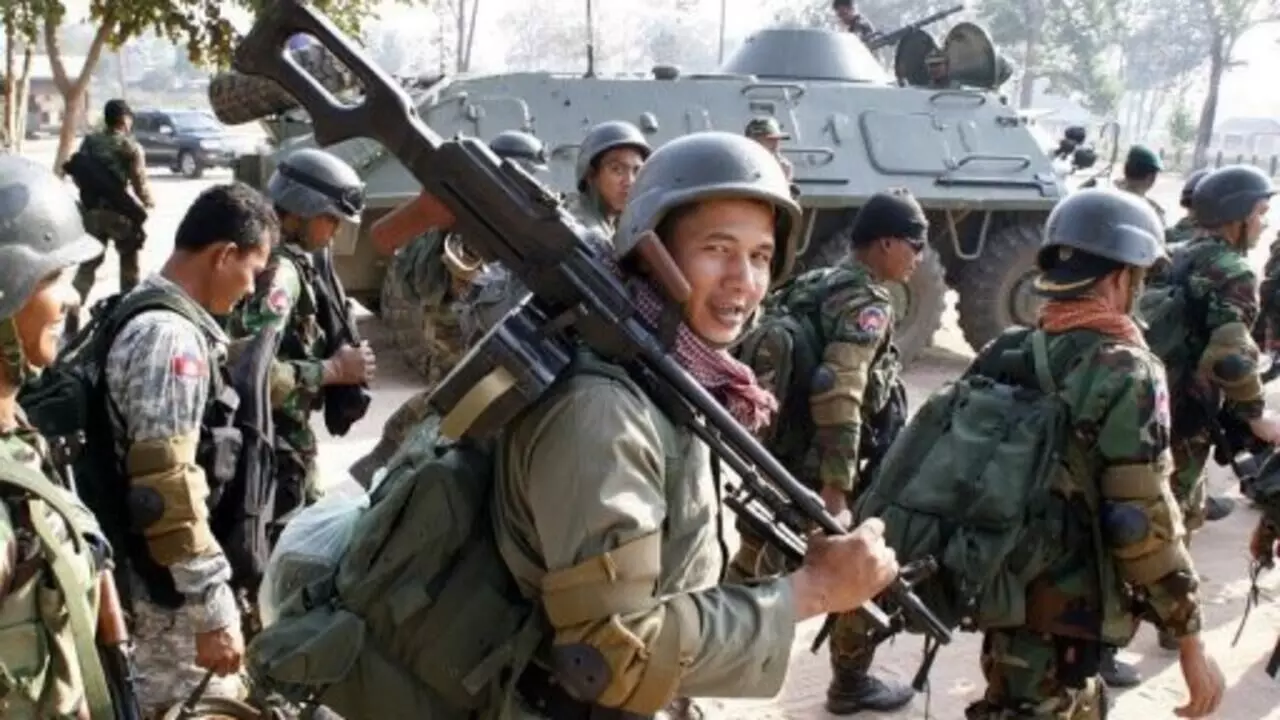Peace in Peril?

The latest border flare-up between Cambodia and Thailand has grown well beyond a routine diplomatic spat. What began with a short but lethal exchange of fire on May 28 in a sliver of disputed “no-man’s land” has snowballed into full-blown national mobilisation: tens of thousands marched through Phnom Penh on Wednesday chanting patriotic songs and pledging fealty to the army, while Bangkok has tightened crossing hours, barred Thai casino workers from entering Cambodia and warned its nationals to stay away. Phnom Penh has replied with a sweeping embargo on Thai movies, television serials, fresh produce and even international internet links routed through Thailand. One Cambodian soldier is already dead; neither side contests that fact, only who shot first. The spat is inflamed by an 800-kilometre frontier never properly demarcated since the French drew their 1907 colonial map. When Cambodian troops sang their national anthem at an ancient border shrine in February it took only minutes for Thai soldiers to arrive and trade insults. History sits heavily here. Memories of the 2011 firefights around the Preah Vihear temple still shape public opinion, and every new skirmish is instantly cast as proof of perfidy by the other side. Nationalist influencers on Thai and Khmer social media have turned a cartographic ambiguity into an existential grievance, ensuring that even modest retaliatory steps—fruit bans, visa limits—land like blows to national honour. Yet the border itself is almost incidental to much deeper political undercurrents roiling both countries. In Bangkok, Prime Minister Paetongtarn Shinawatra—already navigating a still-powerful military and the long shadow of her father’s exile—cannot afford to appear weak. Bangkok’s newspapers point out that every major Thai coup since 1991 has been preceded by a border standoff with either Cambodia or Myanmar. In Phnom Penh, Hun Sen, though no longer prime minister, remains the indispensable nationalist patron; his son and successor Hun Manet owes his legitimacy to projecting the same uncompromising defence of Khmer sovereignty
The International Court of Justice, which awarded Preah Vihear to Cambodia in 1962 and clarified the ruling in 2013, is once again Phnom Penh’s instrument of choice. Cambodia has filed a fresh petition covering several contested pockets, including the site of May’s firefight; Thailand refuses the court’s jurisdiction and insists on reviving a bilateral boundary committee set up in 2000. Meanwhile, both armies have quietly reinforced forward bases. A rare face-to-face between their chiefs earlier this month ended with statements of “calm” but no timetable to restart joint surveys of the frontier. Add in tit-for-tat cultural claims—over everything from shadow-boxing to spicy papaya salad—and the combustible mix of wounded pride, economic pain and unresolved cartography becomes clear. For ASEAN, which has historically prized consensus over confrontation, the dispute is a stern stress-test: if two founding members cannot keep faith with the bloc’s pledge to settle disputes peacefully, its vaunted “ASEAN Way” looks threadbare.
India, with its own hard-learnt lessons in boundary management, should watch this drama with more than passing curiosity. Our investments in the Sihanoukville corridor and the Thai Eastern Economic Zone hinge on regional stability; so do crucial sea-lanes for trans-shipped Indian exports. New Delhi therefore has stakes—and experience—to offer. Quiet back-channel facilitation, technical advice on joint boundary commissions, or even support for an ASEAN-minus-two mediating panel would serve India’s interests while reinforcing its profile as a constructive Indo-Pacific partner. But the larger moral is universal. Colonial-era lines, frozen in antique surveys, retain an emotive charge that modern cartography alone cannot defuse. Confidence-building measures—shared border markets, demilitarised heritage zones, coordinated patrols—are cheap compared to the economic and human cost of escalation. Cambodia and Thailand must step back from performative one-upmanship and return to patient delimitation work, whether under the ICJ’s shadow or a reinvented bilateral mechanism. If they do not, every cancelled tour group, every rotting truckload of fruit at the frontier, and every grieving soldier’s family will testify to the price of letting history dictate the future. The region—and India—cannot afford another flashpoint when the South China Sea is already ablaze with rivalry. It is time for Phnom Penh and Bangkok to trade maps, not missiles.



